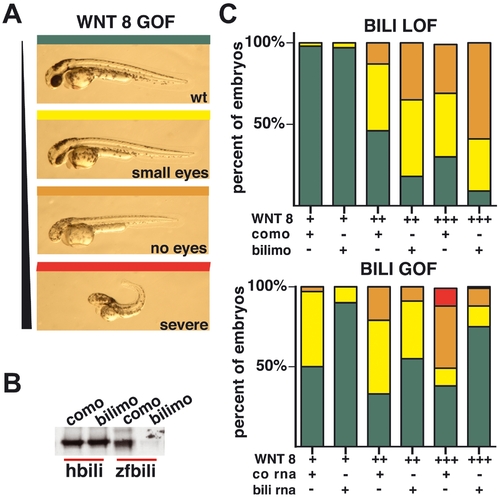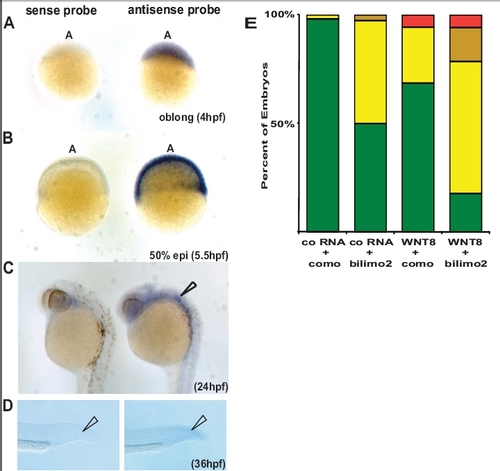- Title
-
Bili inhibits Wnt/beta-catenin signaling by regulating the recruitment of axin to LRP6
- Authors
- Kategaya, L.S., Changkakoty, B., Biechele, T., Conrad, W.H., Kaykas, A., Dasgupta, R., and Moon, R.T.
- Source
- Full text @ PLoS One
|
Bili′s effect on Wnt signaling is conserved in zebrafish. (A) Wnt8 overexpression phenotypes with increasing severity. Embryos were scored as wt (green), small eyes (yellow), no eyes (orange) or severe (red). (B) Morpholino effect on in vitro expression of human Bili (hBili) or zfBili protein (control (como) or zfBili morpholino (bilimo)). (C) In the top panel, the effect of bilimo (loss of function) on Wnt8 GOF phenotype compared to como, is shown (n = 73 low Wnt dose, n = 147 medium Wnt dose, n = 57 high Wnt dose). Bili GOF (bili rna) rescues Wnt8 overexpression phenotype (control Renilla (co rna)). (n = 125 per dose of Wnt8) (bottom panel). |
|
The zebrafish homolog of Bili (zfBili) is expressed during embryogenesis. In situ hybridization using a sense (left column) and antisense probes (right column) were used to detect mRNA. (A) zfBili is expressed maternally as it is detected in the animal pole 4 h post-fertilization. (B) zfBili continues to be expressed ubiquitously at 50% epiboly. (C) 24 hpf zfBili remains ubiquitous but shows specific staining in the otic vesicle (arrow head). (D) Weak Bili expression in the tail at 36 hpf. (E) A second morpholino targeting zfBili (bilimo2) but not a control morpholino (como) enhances the Wnt8 overexpression phenotype (n = 50 for each condition). Embryos were scored as wt (green), small eyes (yellow), no eyes (orange) or severe (red). Data shown is representative from four independent experiments. |


